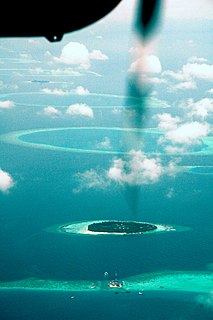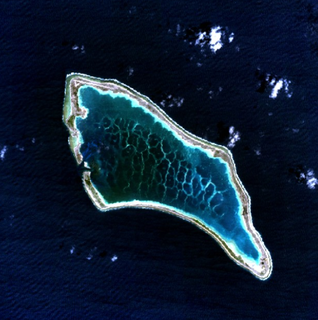
The Cocos (Keeling) Islands, officially the Territory of Cocos (Keeling) Islands, also simply called the Cocos Islands, are an Australian external territory in the Indian Ocean, comprising a small archipelago approximately midway between Australia and Sri Lanka and relatively close to the Indonesian island of Sumatra. The territory's dual name reflects that the islands have historically been known as either the Cocos Islands or the Keeling Islands.

The Western Pacific nation of Tuvalu, formerly known as the Ellice Islands, is situated 4,000 kilometers (2,500 mi) northeast of Australia and is approximately halfway between Hawaii and Australia. It lies east-northeast of the Santa Cruz Islands, southeast of Nauru, south of Kiribati, west of Tokelau, northwest of Samoa and Wallis and Futuna and north of Fiji. It is a very small island country of 26 km2 (10 sq mi). Due to the spread out islands it has the 38th largest Exclusive Economic Zone of 749,790 km2 (289,500 sq mi).

The Oceanian realm is one of the World Wildlife Fund (WWF) biogeographic realms, and is unique in not including any continental land mass. It has the smallest land area of any of the WWF realms.

Caroline Island is the easternmost of the uninhabited coral atolls which comprise the southern Line Islands in the central Pacific Ocean Republic of Kiribati.

The Clunies-Ross family were the original settlers of the Cocos (Keeling) Islands, a small archipelago in the Indian Ocean. From 1827 to 1978, the family ruled the previously uninhabited islands as a private fiefdom, initially as terra nullius and then later under British (1857–1955) and Australian (1955–1978) sovereignty. The head of the family was usually recognised as the resident magistrate, and was sometimes styled as the "King of the Cocos Islands"; a title given by the press.

Pandanus tectorius is a species of Pandanus (screwpine) that is native to Malesia, eastern Australia, and the Pacific Islands. It grows in the coastal lowlands typically near the edge of the ocean. Common names in English include thatch screwpine, Tahitian screwpine, hala tree and pandanus. The edible fruit is sometimes known as hala fruit.

Bikar Atoll is an uninhabited atoll in the Ratak Chain of the Marshall Islands. It is one of the smallest atolls in the Marshalls. Due to its relative isolation from the main islands in the group, Bikar's flora and fauna has been able to exist in a relatively pristine condition.

The terrestrial fauna of the Cocos (Keeling) Islands is unsurprisingly depauperate, because of the small land area of the islands, their lack of diverse habitats, and their isolation from large land-masses. However, the fauna dependent on marine resources is much richer.

North Keeling is a small, uninhabited coral atoll, approximately 1.2 square kilometres (0.46 sq mi) in area, about 25 kilometres (16 mi) north of Horsburgh Island. It is the northernmost atoll and island of the Australian territory of the Cocos (Keeling) Islands. It consists of just one C-shaped island, a nearly closed atoll ring with a small opening into the lagoon, about 50 metres (160 ft) wide, on the east side. The lagoon is about 0.5 square kilometres (0.19 sq mi) in area. The island is home to the only surviving population of the endemic, and endangered, Cocos buff-banded rail, as well as large breeding colonies of seabirds. Since 1995, North Keeling Island and the surrounding sea to 1.5 kilometres (0.93 mi) from shore have been within the Pulu Keeling National Park.

The wildlife of Maldives includes the flora and fauna of the islands, reefs, and the surrounding ocean.

Barringtonia asiatica is a species of Barringtonia native to mangrove habitats from islands of the Indian Ocean in the west to tropical Asia and islands of the western Pacific Ocean. It is grown along streets for decorative and shade purposes in some parts of India, for instance in some towns on the southeastern shore. It is also known as Box Fruit due to the distinct box-shaped fruit it produces. The local name futu is the source of the name for the Polynesian island Futuna. The type specimen was collected by botanist Pehr Osbeck on a sandy beach area on the island of Java, later to be described by Carl Linnaeus in his Species Plantarum in 1753.

The Cocos buff-banded rail, Gallirallus philippensis andrewsi, is an endangered subspecies of the buff-banded rail endemic to the Cocos (Keeling) Islands, an Australian Offshore Territory in the central-eastern Indian Ocean. The local Cocos Malay name of the bird is ayam hutan.

Home Island, also known locally as Pulu Selma, is one of only two permanently inhabited islands of the 26 islands of the Southern Atoll of the Cocos (Keeling) Islands, an Australian external territory in the central-eastern Indian Ocean.

The Structure and Distribution of Coral Reefs, Being the first part of the geology of the voyage of the Beagle, under the command of Capt. Fitzroy, R.N. during the years 1832 to 1836, was published in 1842 as Charles Darwin's first monograph, and set out his theory of the formation of coral reefs and atolls. He conceived of the idea during the voyage of the Beagle while still in South America, before he had seen a coral island, and wrote it out as HMS Beagle crossed the Pacific Ocean, completing his draft by November 1835. At the time there was great scientific interest in the way that coral reefs formed, and Captain Robert FitzRoy's orders from the Admiralty included the investigation of an atoll as an important scientific aim of the voyage. FitzRoy chose to survey the Keeling Islands in the Indian Ocean. The results supported Darwin's theory that the various types of coral reefs and atolls could be explained by uplift and subsidence of vast areas of the Earth's crust under the oceans.

Although it is an Australian External Territory, the culture of the Cocos (Keeling) Islands has extensive influences from Malaysia and Indonesia.

The flora of French Polynesia refers to the native vegetation of the Marquesas Islands, the Tuamotu Archipelago, the Society Islands and the Tubuai Islands, located in Oceania. Due to its type of vegetation, French Polynesia falls within the palaeotropic floral kingdom.
Government House is a heritage-listed official residence at Qantas Close, West Island, Cocos (Keeling) Islands, Australia. It was added to the Australian Commonwealth Heritage List on 22 June 2004.
Captain Ballards Grave is a heritage-listed burial place at Home Island, Cocos (Keeling) Islands, Australia. It was added to the Australian Commonwealth Heritage List on 22 June 2004.

The Tongan tropical moist forests is a tropical and subtropical moist broadleaf forests ecoregion that includes the Tonga archipelago and Niue.

The Christmas and Cocos Islands tropical forests ecoregion covers forested areas of Christmas Island and North Keeling Island, two small seamount islands south of the Indonesian island of Java. The forests of these two islands share tree species of the Indo-Pacific and Melanesian types on nearby islands, the forests of Christmas Island and North Keeling Island are unique in how they reflect the effects of large populations of terrestrial red crabs. Because of the remoteness of the islands, there are many endemic species.
























































































































